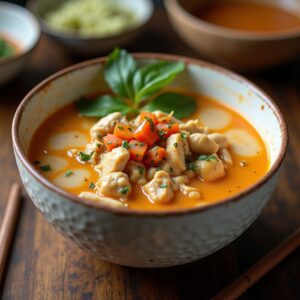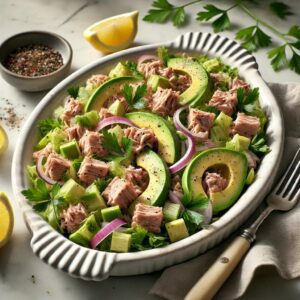

Five Powerful Anti-Inflammatory Foods to Add to Your Diet


Arya Soleil
Inflammation is the body’s natural response to injury, toxins, or infections. While short-term inflammation is essential for healing, chronic inflammation can lead to long-term health issues such as heart disease, arthritis, and autoimmune disorders. The good news? Certain foods can help reduce inflammation and promote overall wellness.
A well-balanced diet filled with anti-inflammatory foods can help mitigate the damage caused by chronic inflammation. Research has shown that lifestyle choices, including diet, play a significant role in determining inflammation levels in the body. This means that what we eat daily can either fuel or reduce inflammation, making dietary choices one of the most powerful tools for maintaining good health.
Here are five anti-inflammatory foods to incorporate into your diet today, along with a deeper look into how inflammation works and what steps you can take to counteract it.
Understanding Inflammation and Its Effects
Before we dive into specific anti-inflammatory foods, it’s important to understand how inflammation works. There are two types of inflammation: acute and chronic.
Acute Inflammation:
Acute inflammation is the body’s immediate response to injury or infection. It helps fight off harmful pathogens, initiate tissue repair, and restore balance. This type of inflammation is necessary and beneficial in the short term.
Chronic Inflammation:
Chronic inflammation, on the other hand, is long-term and can contribute to a variety of health issues. It has been linked to diseases such as diabetes, cardiovascular disease, cancer, and even neurodegenerative conditions like Alzheimer’s. Chronic inflammation can be triggered by factors such as a poor diet, lack of exercise, stress, environmental toxins, and underlying medical conditions.
Now, let’s explore five powerful foods that can actively fight inflammation.
- Ginger: Nature’s Anti-Inflammatory Superfood
Ginger is widely known for its anti-inflammatory properties, making it a staple in many traditional healing practices, including Chinese medicine. This powerful root improves digestion, enhances circulation, and supports the body’s natural detoxification processes. Proper circulation ensures that waste and toxins are efficiently removed, keeping the body in balance.
The Science Behind Ginger’s Benefits
Ginger contains bioactive compounds such as gingerol, which has potent anti-inflammatory and antioxidant effects. Research suggests that ginger can help reduce inflammation associated with osteoarthritis, muscle pain, and even gut-related issues like irritable bowel syndrome (IBS).
How to Use Ginger:
Brew fresh ginger tea by boiling sliced ginger in water; add honey for a touch of sweetness.
Juice fresh ginger and mix it with other fruits and vegetables for an extra health boost.
Incorporate it into stir-fries, soups, and marinades for a flavorful, anti-inflammatory kick.
- Cayenne Pepper: A Spicy Solution for Inflammation
Cayenne pepper is a potent spice that stimulates circulation and supports cardiovascular health. Its active compound, capsaicin, helps open capillaries and improve blood flow, which reduces inflammation and promotes healing.
The Role of Capsaicin in Reducing Inflammation
Capsaicin has been studied for its ability to reduce inflammation, particularly in cases of arthritis and nerve pain. It can also help lower blood pressure and improve metabolism, making it a powerful addition to an anti-inflammatory diet.
How to Use Cayenne Pepper:
Sprinkle cayenne pepper onto roasted vegetables, meats, or soups.
Add a dash to your morning smoothie for an energizing boost.
Mix it with lemon and honey in warm water for a detoxifying drink.
- Garlic: A Natural Inflammatory Fighter
Garlic is a natural powerhouse known for its antifungal, antiviral, and antiparasitic properties. It helps clean the blood, reduce arterial plaque, and combat harmful pathogens that may cause inflammation in the body.
The Science Behind Garlic’s Benefits
Garlic contains sulfur compounds, including allicin, which has been shown to reduce inflammation and support immune function. Studies indicate that garlic consumption is associated with a lower risk of chronic diseases such as heart disease and high blood pressure.
How to Use Garlic:
Cook with fresh garlic to add depth of flavor to your meals while reaping its health benefits.
Eat raw garlic occasionally for a stronger medicinal effect—but cycle on and off to prevent imbalances.
Roast whole garlic cloves for a milder taste and spread them on toast or mix them into dips.
- Apple Cider Vinegar: Supporting Digestion and Reducing Inflammation
Apple cider vinegar (ACV) may not be a direct anti-inflammatory, but it supports digestion, kidney function, and overall circulation. When digestion improves, the body is more efficient at eliminating toxins, which in turn reduces inflammation.
The Benefits of ACV for Inflammation
ACV contains acetic acid, which has antimicrobial and antioxidant properties. Some research suggests that ACV can help regulate blood sugar levels, aid digestion, and promote a balanced pH in the body, all of which contribute to lower inflammation.
How to Use Apple Cider Vinegar:
Mix 1-2 tablespoons of ACV in a glass of water and drink it in the morning.
Combine it with baking soda for a fizzy drink that aids digestion.
Use it as a salad dressing with olive oil and herbs.
- Eliminate Inflammatory Foods: Dairy & Gluten
While adding anti-inflammatory foods to your diet is important, eliminating certain pro-inflammatory foods can be just as beneficial. Pasteurized dairy and gluten are common triggers for inflammation in many people. By cutting these out for 60 days, you may experience reduced bloating, joint pain, and overall inflammation.
Why Dairy and Gluten Contribute to Inflammation
Dairy contains casein, a protein that can trigger inflammatory responses in sensitive individuals. Similarly, gluten, found in wheat and other grains, can cause gut inflammation, particularly in those with gluten sensitivities or celiac disease.
How to Make the Switch:
Opt for dairy-free alternatives like almond, coconut, or oat milk.
Replace traditional wheat products with gluten-free options like quinoa, rice, or almond flour.
Monitor your body’s response after eliminating these foods to determine their impact on your health.
Additional Anti-Inflammatory Lifestyle Tips
Besides incorporating anti-inflammatory foods, there are other lifestyle changes you can make to further reduce inflammation:
Stay Hydrated: Drinking enough water helps flush out toxins.
Exercise Regularly: Moderate exercise can help regulate inflammation levels in the body.
Manage Stress: Chronic stress can contribute to inflammation, so practicing mindfulness, meditation, or yoga can be beneficial.
Get Enough Sleep: Poor sleep patterns have been linked to increased inflammatory markers.
Final Thoughts
Incorporating these five anti-inflammatory foods into your diet can improve circulation, support digestion, and enhance overall well-being. Whether it’s sipping on ginger tea, sprinkling cayenne pepper on your meals, or eliminating inflammatory foods like dairy and gluten, small changes can lead to significant health benefits. Try these strategies for a healthier, inflammation-free lifestyle!
Recommended Reads

- March 22, 2025
Anti-Inflammatory Breakfasts: Easy Recipes to Start Your Day Right
Home News Healthy Habits & Lifestyle Health Conditions &...


- March 22, 2025
Questioning the FDA: A Deeper Look at the Food and Drug Administration’s Role
Home News Healthy Habits & Lifestyle Health Conditions &...


- March 22, 2025
Make ‘Raw Milk’ Just ‘Milk’ Again: A Closer Look at the Raw Milk Debate
Home News Healthy Habits & Lifestyle Health Conditions &...


- March 22, 2025
The Power of Sweet Potatoes: A Superfood for Eyes, Skin, and Beyond
Home News Healthy Habits & Lifestyle Health Conditions &...


- March 22, 2025
Sugar-Free: A Code Word for “We’ve Replaced It with Something Worse for You”
Home News Healthy Habits & Lifestyle Health Conditions &...


- March 22, 2025
The Evolution of Food: How Modern Diets Are Fueling Chronic Disease
Home News Healthy Habits & Lifestyle Health Conditions &...

Five Powerful Anti-Inflammatory Foods to Add to Your Diet

Inflammation is the body’s natural response to injury, toxins, or infections. While short-term inflammation is essential for healing, chronic inflammation can lead to long-term health issues such as heart disease, arthritis, and autoimmune disorders. The good news? Certain foods can help reduce inflammation and promote overall wellness.
A well-balanced diet filled with anti-inflammatory foods can help mitigate the damage caused by chronic inflammation. Research has shown that lifestyle choices, including diet, play a significant role in determining inflammation levels in the body. This means that what we eat daily can either fuel or reduce inflammation, making dietary choices one of the most powerful tools for maintaining good health.
Here are five anti-inflammatory foods to incorporate into your diet today, along with a deeper look into how inflammation works and what steps you can take to counteract it.
Understanding Inflammation and Its Effects
Before we dive into specific anti-inflammatory foods, it’s important to understand how inflammation works. There are two types of inflammation: acute and chronic.
Acute Inflammation:
Acute inflammation is the body’s immediate response to injury or infection. It helps fight off harmful pathogens, initiate tissue repair, and restore balance. This type of inflammation is necessary and beneficial in the short term.
Chronic Inflammation:
Chronic inflammation, on the other hand, is long-term and can contribute to a variety of health issues. It has been linked to diseases such as diabetes, cardiovascular disease, cancer, and even neurodegenerative conditions like Alzheimer’s. Chronic inflammation can be triggered by factors such as a poor diet, lack of exercise, stress, environmental toxins, and underlying medical conditions.
Now, let’s explore five powerful foods that can actively fight inflammation.
- Ginger: Nature’s Anti-Inflammatory Superfood
Ginger is widely known for its anti-inflammatory properties, making it a staple in many traditional healing practices, including Chinese medicine. This powerful root improves digestion, enhances circulation, and supports the body’s natural detoxification processes. Proper circulation ensures that waste and toxins are efficiently removed, keeping the body in balance.
The Science Behind Ginger’s Benefits
Ginger contains bioactive compounds such as gingerol, which has potent anti-inflammatory and antioxidant effects. Research suggests that ginger can help reduce inflammation associated with osteoarthritis, muscle pain, and even gut-related issues like irritable bowel syndrome (IBS).
How to Use Ginger:
Brew fresh ginger tea by boiling sliced ginger in water; add honey for a touch of sweetness.
Juice fresh ginger and mix it with other fruits and vegetables for an extra health boost.
Incorporate it into stir-fries, soups, and marinades for a flavorful, anti-inflammatory kick.
- Cayenne Pepper: A Spicy Solution for Inflammation
Cayenne pepper is a potent spice that stimulates circulation and supports cardiovascular health. Its active compound, capsaicin, helps open capillaries and improve blood flow, which reduces inflammation and promotes healing.
The Role of Capsaicin in Reducing Inflammation
Capsaicin has been studied for its ability to reduce inflammation, particularly in cases of arthritis and nerve pain. It can also help lower blood pressure and improve metabolism, making it a powerful addition to an anti-inflammatory diet.
How to Use Cayenne Pepper:
Sprinkle cayenne pepper onto roasted vegetables, meats, or soups.
Add a dash to your morning smoothie for an energizing boost.
Mix it with lemon and honey in warm water for a detoxifying drink.
- Garlic: A Natural Inflammatory Fighter
Garlic is a natural powerhouse known for its antifungal, antiviral, and antiparasitic properties. It helps clean the blood, reduce arterial plaque, and combat harmful pathogens that may cause inflammation in the body.
The Science Behind Garlic’s Benefits
Garlic contains sulfur compounds, including allicin, which has been shown to reduce inflammation and support immune function. Studies indicate that garlic consumption is associated with a lower risk of chronic diseases such as heart disease and high blood pressure.
How to Use Garlic:
Cook with fresh garlic to add depth of flavor to your meals while reaping its health benefits.
Eat raw garlic occasionally for a stronger medicinal effect—but cycle on and off to prevent imbalances.
Roast whole garlic cloves for a milder taste and spread them on toast or mix them into dips.
- Apple Cider Vinegar: Supporting Digestion and Reducing Inflammation
Apple cider vinegar (ACV) may not be a direct anti-inflammatory, but it supports digestion, kidney function, and overall circulation. When digestion improves, the body is more efficient at eliminating toxins, which in turn reduces inflammation.
The Benefits of ACV for Inflammation
ACV contains acetic acid, which has antimicrobial and antioxidant properties. Some research suggests that ACV can help regulate blood sugar levels, aid digestion, and promote a balanced pH in the body, all of which contribute to lower inflammation.
How to Use Apple Cider Vinegar:
Mix 1-2 tablespoons of ACV in a glass of water and drink it in the morning.
Combine it with baking soda for a fizzy drink that aids digestion.
Use it as a salad dressing with olive oil and herbs.
- Eliminate Inflammatory Foods: Dairy & Gluten
While adding anti-inflammatory foods to your diet is important, eliminating certain pro-inflammatory foods can be just as beneficial. Pasteurized dairy and gluten are common triggers for inflammation in many people. By cutting these out for 60 days, you may experience reduced bloating, joint pain, and overall inflammation.
Why Dairy and Gluten Contribute to Inflammation
Dairy contains casein, a protein that can trigger inflammatory responses in sensitive individuals. Similarly, gluten, found in wheat and other grains, can cause gut inflammation, particularly in those with gluten sensitivities or celiac disease.
How to Make the Switch:
Opt for dairy-free alternatives like almond, coconut, or oat milk.
Replace traditional wheat products with gluten-free options like quinoa, rice, or almond flour.
Monitor your body’s response after eliminating these foods to determine their impact on your health.
Additional Anti-Inflammatory Lifestyle Tips
Besides incorporating anti-inflammatory foods, there are other lifestyle changes you can make to further reduce inflammation:
Stay Hydrated: Drinking enough water helps flush out toxins.
Exercise Regularly: Moderate exercise can help regulate inflammation levels in the body.
Manage Stress: Chronic stress can contribute to inflammation, so practicing mindfulness, meditation, or yoga can be beneficial.
Get Enough Sleep: Poor sleep patterns have been linked to increased inflammatory markers.
Final Thoughts
Incorporating these five anti-inflammatory foods into your diet can improve circulation, support digestion, and enhance overall well-being. Whether it’s sipping on ginger tea, sprinkling cayenne pepper on your meals, or eliminating inflammatory foods like dairy and gluten, small changes can lead to significant health benefits. Try these strategies for a healthier, inflammation-free lifestyle!
Recommended Reads

- March 22, 2025
Anti-Inflammatory Breakfasts: Easy Recipes to Start Your Day Right
Home News Healthy Habits & Lifestyle Health Conditions &...


- March 22, 2025
Questioning the FDA: A Deeper Look at the Food and Drug Administration’s Role
Home News Healthy Habits & Lifestyle Health Conditions &...


- March 22, 2025
Make ‘Raw Milk’ Just ‘Milk’ Again: A Closer Look at the Raw Milk Debate
Home News Healthy Habits & Lifestyle Health Conditions &...


- March 22, 2025
The Power of Sweet Potatoes: A Superfood for Eyes, Skin, and Beyond
Home News Healthy Habits & Lifestyle Health Conditions &...


- March 22, 2025
Sugar-Free: A Code Word for “We’ve Replaced It with Something Worse for You”
Home News Healthy Habits & Lifestyle Health Conditions &...


- March 22, 2025
The Evolution of Food: How Modern Diets Are Fueling Chronic Disease
Home News Healthy Habits & Lifestyle Health Conditions &...



